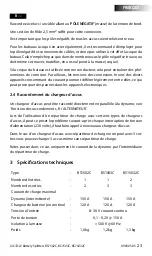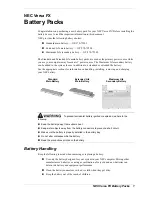
12
090305.05
vetus®
Battery Splitters BS1502C, BS1503C, BS15032C
4 Testing and trouble shooting
In case of doubt about the correct operation of the battery splitter the following
test can be carried out using a simple multimeter or voltmeter.
First check if wiring is connected as indicated in the diagrams and that the minus
terminals of all batteries are interconnected.
Measure the voltages as indicated in the diagrams on page 50 and 51.
(1) If the nominal battery voltage is being measured on the loose wire encl, while
the engine is stopped and the battery charger is switched off, then the B+ ter-
minal of the alternator is still directly connected to the + terminal of the starter
relay. See also chapter ‘Installation’ - Function of the terminals.
Remove the connection from alternator B+ to starter relay.
(2) If the voltage at all terminals is about the same but the voltage does not in-
crease to the desired value then the charge voltage of the alternator or battery
charger is set incorrectly.
In the case of fully discharged batteries it may take some time before the
charge voltage will increase.
Note: The battery voltage will never be higher than the voltage at the
B+ALTERNATOR terminal of the battery splitter!
(3) If the alternator warning light remains on after the engine has been started but
still operating at idle speed, the alternator isn’t charging. Therefore, increase for
a short period of time the rpm of the engine.
If the alternator doesn’t charge any more after installation of the battery splitter
then check the terminal for the exciting current.
This terminal must be connected via the key-switch and an alternator warning
light to the battery and not to the B+ of the alternator. See drawing at page 47.
Note: It is possible that after installation of the battery splitter the engine con-
trol panel or other equipment does not function (properly).
The power supply for engine panel or equipment in such a case is directly con-
nected to the B+ terminal of the alternator. This is incorrect installation. Con-
nect the supply directly to the battery or to a distribution rail for the consum-
ers.
4.1 LED-Indicator
When DC power is available from the battery charger or the alternator, the green
LED on top of the battery splitter illuminates.













































